How much advance planning goes into the average home-cooked meal? It turns out, very little. According to recent research, more than 8 out of 10 meals prepared at home were either “a last-second decision” or “briefly decided in advance.” With everything life throws at us, sometimes planning weekly meals just doesn’t make it to the top of the list.
So, what’s the secret to meal planning success? Having a well-stocked pantry, fridge, and freezer! Food staples are the building blocks of healthy home cooking. With the right ingredients on hand, you can whip up countless nutritious, delicious meals at a moment’s notice—whether you cook for yourself or a large family.
YOUR GO-TO GROCERY LIST
 Our favorite pantry staples deliver on a few key criteria: They’re packed with good nutrition, are versatile enough to use in many different recipes, are easy to find in most grocery stores, are available year-round, and are easy on the budget. We reached out to our chefs and registered dietitians to get some of their must-have food staples, then organized the items by where you’ll find them in the supermarket.
Our favorite pantry staples deliver on a few key criteria: They’re packed with good nutrition, are versatile enough to use in many different recipes, are easy to find in most grocery stores, are available year-round, and are easy on the budget. We reached out to our chefs and registered dietitians to get some of their must-have food staples, then organized the items by where you’ll find them in the supermarket.
The next time you’re in a rush or need a dinner back-up plan, you’ll be glad you have these superstars on hand.
CANNED & DRY GOODS
1. Beans
Why we love it: Beans are a dense source of plant-based protein. We love black beans, northern beans, kidney beans, pinto beans …. The list goes on!
Look for: Cans labeled “low sodium” or “no salt added.”
Keep in mind: Drain the beans, rinse, and go. If you have a little extra time, you also can cook dried beans from scratch.
Try it in: Black Bean & Kale Tacos
2. Tomatoes
Why we love it: Tomatoes, in all their many forms, are a good source of potassium and an excellent source of vitamins A and C.
Look for: Cans labeled “low sodium” or “no salt added.”
Keep in mind: In addition to plain, canned tomatoes come in flavors like fire-roasted, basil and garlic, and with chiles. That calls for experimentation!
Try it in: Moroccan Vegetable Stew
3. Tuna
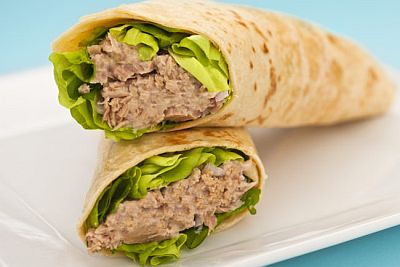 Why we love it: Fish and other seafood are among the healthiest foods on the planet, in part because they’re a rich source of heart-healthy omega-3 fatty acids.
Why we love it: Fish and other seafood are among the healthiest foods on the planet, in part because they’re a rich source of heart-healthy omega-3 fatty acids.
Look for: Light tuna packed in water, which contains less mercury than white or albacore tuna.
Keep in mind: Tuna sandwiches are a classic, but don’t stop there! Add tuna atop your green salads or mix it into pasta dishes.
Try it in: Perfect Lunch Tuna Wrap
4. Broth
Why we love it: Chicken and vegetable broths are the basis of so many soup recipes and can make a great savory hot drink. There is no better way to fill up on a cold day!
Look for: Low-sodium varieties.
Keep in mind: When preparing brown rice and other whole grains, you can replace some of or all the water with broth for extra flavor.
Try it in: Vegetable Orzo Soup
5. Peanut Butter
Why we love it: This kid-friendly sandwich spread is a source of plant-based protein and unsaturated fats.
Look for: Brands with low or no added sugar. Plus, the fat in peanut butter is the “good” kind!
Keep in mind: Think twice about the lower-fat versions; they can be higher in sugar. Peanut butter has a long shelf life—up to 9 months unopened and up to 3 months opened (longer if you refrigerate it)—so stock up! If you have a peanut allergy, go for other nut and seed butters like almond, flaxseed or sunflower—they’re just as handy in the kitchen!
Try it in: Peanut Butter Chili
GRAINS
6. Whole-Grain Bread
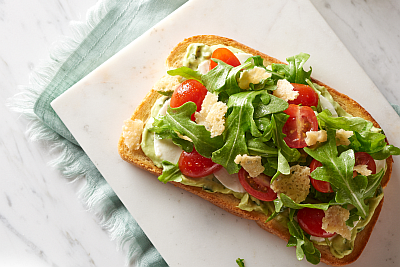 Why we love it: When you choose whole grains over refined grains, you’ll reap the benefits of fiber, B vitamins and other nutrients.
Why we love it: When you choose whole grains over refined grains, you’ll reap the benefits of fiber, B vitamins and other nutrients.
Look for: Breads labeled “100% whole grain” or “100% whole wheat.”
Keep in mind: Bread freezes well and defrosts quickly. Stash it in the freezer and take out however many slices you need each time.
Try it in: Caprese Avocado Toast
7. Brown Rice
Why we love it: Brown rice is a good source of the B vitamins thiamin, niacin and B6. And it has a deliciously nutty flavor.
Look for: The quick-cooking kind, which you can get on the table in about 15 minutes. Nutritionally speaking, there is very little difference between this and regular brown rice.
Keep in mind: That nutritious bran layer contains a little bit of oil, which means brown rice has a shorter shelf life than white rice. Buy what your family can eat within 6 months. Brown rice and other whole grains can be pre-cooked and frozen for a lightning-fast side dish or addition to soups, casseroles, and salads.
Try it in: Easy Jazzy Jambalaya
8. Whole-Wheat Pasta
Why we love it: The fiber in whole-wheat pasta helps you stay fuller longer. It also contributes to a lower glycemic index, which means whole-wheat pasta can have a lower impact on blood sugar than white pasta.
Look for: “100% whole grain” or “100% whole wheat” on the package.
Keep in mind: Wheat may be most common, but it’s not the only whole-grain pasta out there! Try pasta made from buckwheat, brown rice or quinoa.
Try it in: Spicy Shrimp and Penne
9. Oats
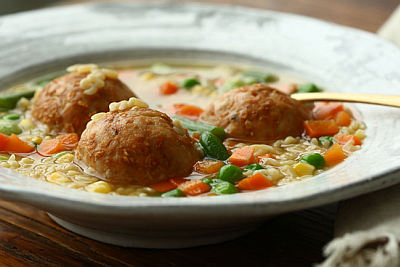 Why we love it: According to the American Heart Association (AHA), oats have a greater proportion of soluble fiber than any other grain—that’s the kind that can help reduce your blood cholesterol levels.
Why we love it: According to the American Heart Association (AHA), oats have a greater proportion of soluble fiber than any other grain—that’s the kind that can help reduce your blood cholesterol levels.
Look for: Whole or rolled oats (steel cut, regular, quick or instant).
Keep in mind: We love oats for breakfast, but they can make an equally impressive appearance at lunch and dinner.
Try it in: ABC Meatball Soup
MEAT, EGGS & DAIRY
10. Chicken Breasts
Why we love it: Ounce for ounce, chicken is one of the leaner animal proteins out there. It can take on the flavors of practically any cuisine.
Look for: Skinless chicken breasts, which contain the least saturated fat.
Keep in mind: Slice and cook chicken breast strips and refrigerate or freeze for a time-saving solution for salads, stir-fries and pasta dishes.
Try it in: Hearty Chicken Gumbo
11. Ground Turkey
Why we love it: Ground meat is the foundation of many favorite foods from burgers and meatloaf to tacos and chili.
Look for: Lean ground turkey with 10% fat or less (these will be labeled as 90/10, 93/7, 95/5, etc.).
Keep in mind: For a nutritious boost, mix in umami-rich mushrooms or diced eggplant.
Try it in: Joaquin’s Texas Chili
12. Greek Yogurt
Why we love it: Greek yogurt is brimming with calcium and an excellent source of high-quality protein. It also tends to be lower in sugar than regular yogurt.
Look for: Plain varieties, either low-fat or non-fat. That way, you can add your own mix-ins.
Keep in mind: Greek yogurt isn’t just for breakfast. Swap it for sour cream or mayo or use it to thicken sauces, dips, and dressings. Or serve it for dessert!
Try it in: Chicken Avocado Salad Wrap
13. Eggs
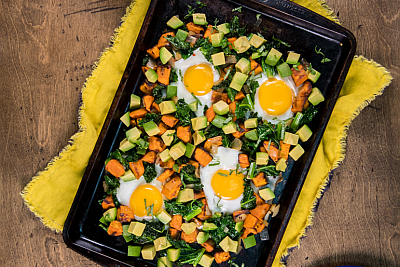 Why we love it: Eggs are hailed for how much high-quality protein they pack at only 70 calories each. Eggs also provide 13 essential vitamins and minerals, including the nutrient choline, which is essential for brain health.
Why we love it: Eggs are hailed for how much high-quality protein they pack at only 70 calories each. Eggs also provide 13 essential vitamins and minerals, including the nutrient choline, which is essential for brain health.
Look for: Eggs come in several sizes, but large eggs are the most common both on grocery store shelves and in recipes.
Keep in mind: Eggs, yolk and all, are no longer thought to raise blood cholesterol when consumed in moderation. According to the AHA, most healthy people can eat one egg per day without increasing their risk of heart disease.
Try it in: Sheet Pan Breakfast
14. Milk
Why we love it: It’s a great source of protein and vitamin D.
Look for: Low-fat or fat-free.
Keep in mind: Have a dairy intolerance? Check out milk alternatives such as soy, almond or rice milk. Just be cautious of the added sugars in some flavored varieties. If you don’t use milk often enough to keep it fresh in the fridge, store a shelf-stable carton in your pantry so you always have it on hand.
Try it in: Mint Chocolate Chip Smoothie
PRODUCE
15. Onions
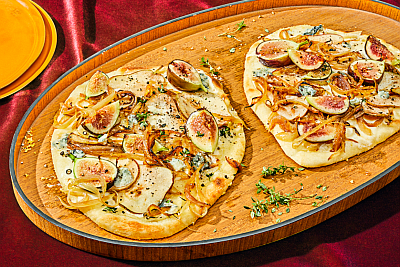 Why we love it: Onions are one of the most shelf-stable types of produce you can buy. They are known for their antioxidant and anti-inflammatory properties and, as part of a healthy diet, may help reduce the risk of heart disease and several types of cancer.
Why we love it: Onions are one of the most shelf-stable types of produce you can buy. They are known for their antioxidant and anti-inflammatory properties and, as part of a healthy diet, may help reduce the risk of heart disease and several types of cancer.
Look for: Any variety such as red, white, yellow, green or sweet. Everything from omelets and salads to sandwiches and stir-fries tastes better with the addition of a flavorful onion!
Keep in mind: To keep onions fresh, store them in a dry area in their mesh bag or loose (never in plastic!) where the temperature stays between 30 and 50 degrees. They should keep for about a month.
Try it in: Fig, Pear and Caramelized Onion Flatbread
16. Frozen Vegetables
Why we love it: Frozen veggies such as spinach, peas and broccoli totally count toward your produce goals! Because frozen produce is harvested at the peak of freshness, you can expect excellent, consistent quality.
Look for: Plain varieties without added salt or sauces.
Keep in mind: Frozen vegetable blends (Italian, Asian, California and so on) make stir-fries and pasta tosses a snap.
Try it in: Light & Zesty Spinach Pasta Toss
17. Frozen Berries
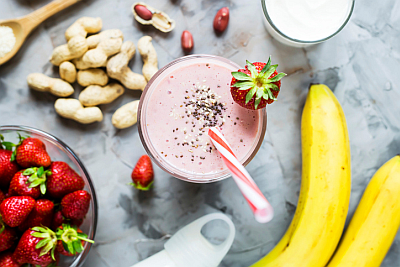 Why we love it: Berries are low in calories and high in fiber, vitamin C and antioxidants. And who doesn’t want to enjoy blueberries, strawberries, and raspberries year-round?
Why we love it: Berries are low in calories and high in fiber, vitamin C and antioxidants. And who doesn’t want to enjoy blueberries, strawberries, and raspberries year-round?
Look for: Fruit with no added sugar.
Keep in mind: Using fruit that’s still frozen will make for a thicker smoothie (but make sure your blender can handle it). For an easier-to-blend smoothie where the flavors of the fruit really pop, defrost your berries first.
Try it in: Nutty Banana Berry Smoothie
OILS & SEASONINGS
18. Olive Oil
Why we love it: With its quintessentially Mediterranean flavor, olive oil is an all-star in the kitchen—not to mention a source of healthy fats.
Look for: Extra virgin olive oil, which has the most robust flavor.
Keep in mind: Olive oil has a lower smoke point than other oils, so take care when turning up the heat.
Try it in: Herbed Orange Chicken
19. Lemon Juice
Why we love it: A squeeze of lemon juice adds bright flavor to sauces, dressings, and marinades, and adds a dash of immune-supporting vitamin C.
Look for: Fruits that are firm to the touch.
Keep in mind: Fresh is always best (whole lemons should last a few weeks in the fridge), but bottled lemon juice also works.
Try it in: Chicken with Lemon Artichoke Sauce
20. Dried Spices & Herbs
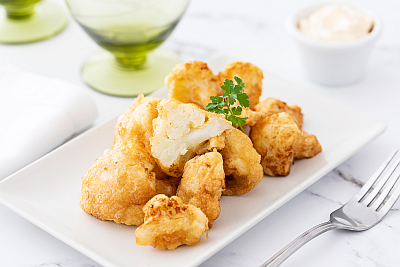 Why we love it: Dried spices and seasonings can impart heart-healthy flavor without racking up the sodium.
Why we love it: Dried spices and seasonings can impart heart-healthy flavor without racking up the sodium.
Look for: Black pepper, chili powder, garlic powder, Italian seasoning, paprika—whatever your family enjoys!
Keep in mind: Check the label to make sure salt isn’t an ingredient, as can be the case with spice blends and other convenience products.
Try it in: Baked Cauliflower Bites
STAPLES SAVE THE DAY
With this list in hand, you can stock up on food staples and then buy fresh groceries as needed. If you have kids, take them shopping with you! Children of all ages can help plan meals, select items off the shelves, and assist with kitchen tasks like rinsing and stirring. It’s all part of building healthy habits that will serve them well for life.
Happy shopping and cooking! For more ways to use up food staples, turn to our recipe page.
Note: Since everyone’s health history and nutritional needs are so different, please make sure that you talk with your doctor and a registered dietitian to get advice about the diet and exercise plan that‘s right for you.

